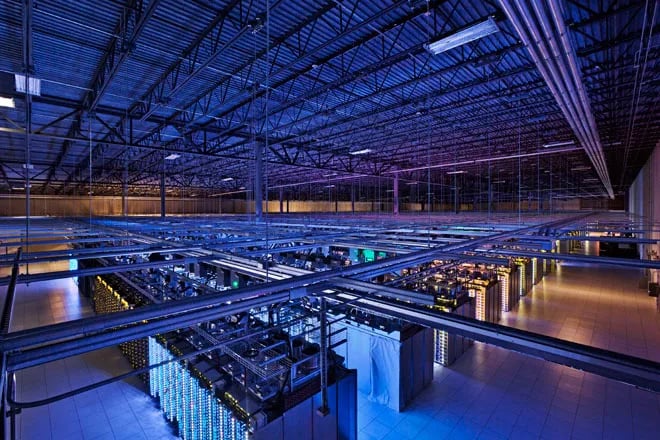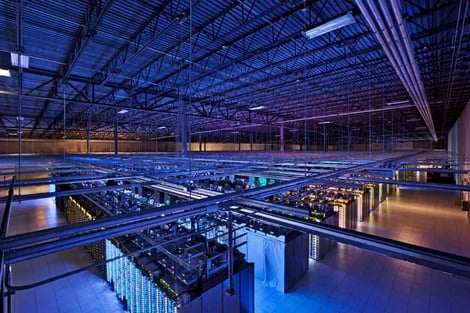
Google has data centers all over the world making sure the internet is humming day and night.
While Google does not disclose the total number of servers it is running, Gartner estimated in 2016 that the tech behemoth had 2.5 million servers in operation.
Google needs all that processing power because StatCounter says the company has 91.86 percent of the search market as of July 2021.
All that search traffic, according to Review 42, leads to:
- 70,000 Google searches each second
- 227 million Google searches each hour
- 5.4 billion Google searches per day
Google Invests in Data Center Infrastructure
All of this takes infrastructure such as data centers and Google invested an estimated $47 billion in tech infrastructure during the last three years.
Back in 2019, Google CEO Sundar Pichai announced $13 billion investments for that year in data centers alone, with major expansions in 14 states.
“Our new data center investments, in particular, will enhance our ability to provide the fastest and most reliable services for all our users and customers,” Pichai wrote. “With this new investment, Google will now have a home in 24 total states, including data centers in 13 communities.”
Google choosing a community for a new data center can bring economic advantages.
“Our data centers make a significant economic contribution to local communities, as do the associated $5 billion in energy investments that our energy purchasing supports,” Pichai wrote.
So, how does Google choose where to put a new data center?
Google Data Center Selection a Balancing Act
Google customizes a lot of its data center design and its process for selecting a data center site is based on balancing a variety of factors.
For Google, a data center location must have the right combination of:
- Energy infrastructure
- Proximity to Google Users
- Available workforce
- Available land
“Some of our data center campuses are the size of hundreds of American football fields,” says Google.

PHOTO: GOOGLE/CONNIE ZHOU
Playing Nice with Mother Nature
One of the first things that Google accesses when looking at an area to locate a data center is exposure to natural disasters.
“Areas that are prone to earthquakes, extreme weather events, or floods are not good candidates to house thousands of machines,” Google says. “Though sometimes it is unavoidable for what we are looking for.”
In those cases, Google accommodates the data center location through design.
“In case unexpected scenarios arise we design for redundant power supplies and data replication,” says Google.
Fiber Network Connectivity and Power Sources are Key
Google wants to locate data centers with access to fiber network connectivity.
“Understanding latency limits and distance to nearby points of presence, or network access points, is a major piece of the puzzle,” says Google.
Since power is a high ongoing cost, and impacts the environment, Google always searches for reliable and efficient carbon-free energy options to ensure sustainable operations around the clock.
Areas with temperate climates, or other suitable environments, provide options for 100 percent outdoor air or water cooling to augment or replace mechanical air conditioning.
“Finding data center sites with unique geography qualities can improve environmental performance,” says Google.
Real World Examples of Google Data Center Sites
Looking at the criteria above, here are some real-world examples of data center sites chosen by Google:
- Google Data Center in St. Ghislain, Belgium: Google uses recycled water from a nearby industrial canal to cool its servers, making it more sustainable and the first Google data center to eliminate refrigerated cooling.
- Google Data Center in Hamina, Finland: Google transformed an old paper mill, located next to the Bay of Finland, into a data center. The bay’s water sitting at 57 degrees Fahrenheit or 14 degrees Celsius all year round, allows Google to use seawater to cool the data center.
- Google Data Center in Changhua County, Taiwan: This data center is one of Google’s most efficient and environmentally friendly in Asia. This data center uses nighttime cooling and a thermal energy storage system to cool water at night when temperatures are lower, storing it in large, insulated tanks. Then during the day it is pumped throughout the facility to cool the servers.
- Google Data Center in Eemshaven, The Netherlands: Thanks in part to a partnership with Dutch farmer cooperatives, this data center sources carbon-free power directly from local wind farms.
- Google Data Center in Dublin, Ireland: This data center uses an advanced air-cooling system that takes advantage of Ireland’s temperate weather to keep the servers running smoothly. As a result, the data center can be cooled efficiently with outdoor air, instead of air conditioning units.
As you can see, there’s no one-size-fits-all data center site for Google.
“Each data center is built to adapt to local strengths and thrive,” says Google.
At Data Center Systems (DCS) we understand that there is not a one-size-fits all approach when it comes to your data center design and cabling infrastructure.
Contact DCS today to find out how we can provide your data center with reliable, scalable, high-performance connectivity that will serve your needs both now and in the future.
Subscribe to News
Recent posts
LATEST NEWS
Monday October 30, 2023







